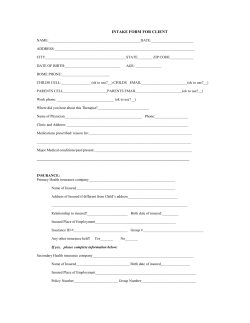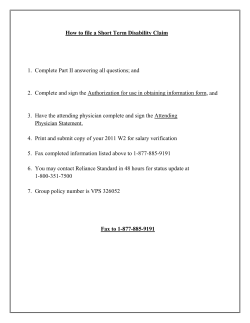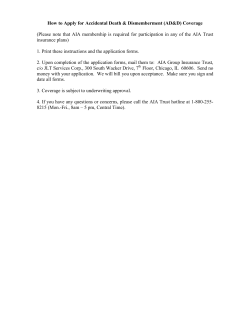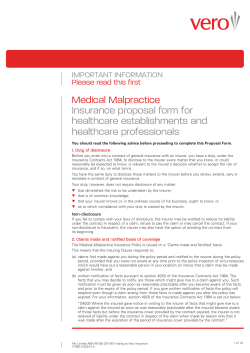
Q UARTERLY
ON COLOR BACKGROUND QUARTERLY VOL. 63, NO. 1 ON WHITE BACKGROUND FALL, 2012 CLAIMS-MADE COVERAGE: WHAT IS A CLAIM? Thomas R. Newman ONGOING CONFUSION OVER WHO QUALIFIES FOR ADDITIONAL INSURED COVERAGE Diane L. Polscer and Brian C. Hickman LOSE THE EVIDENCE, LOSE YOUR CASE: UNDERSTANDING AND AVOIDING SPOLIATION OF EVIDENCE Guy R. Gruppie, Mhare O. Mouradian and Katherine A. Winder CLASS ACTION SETTLEMENT STRUCTURES Wystan M. Ackerman Browse this Edition FDCC Quarterly/Fall 2012 Claims-Made Coverage: What is a Claim? Thomas R. Newman I. Introduction Although claims-made policies1 have been commonplace since 1986 when, in the midst of a perceived liability insurance capacity crisis, the Insurance Services Office (ISO) introduced its CG 00 02 11 85, Commercial General Liability (“CGL”) Coverage Form, to replace the 1973 edition of the comprehensive general liability coverage part and related forms and endorsements, none of the various iterations of the ISO CGL claims-made coverage form have ever contained a definition of the term “claim.” While the omission of a definition for a trigger of coverage2 may surprise some, it has not proved troublesome in the case of CGL policies, which cover the insured against claims seeking damages for “bodily injury,” “property damage” and “personal and advertising injury.” As one court noted, “[r]easonably minded people would have no trouble figuring out what the word claim means when that word stands alone without some other word or phrase Unlike an occurrence-based policy that covers injury or damage taking place during the policy period regardless of when a claim is made or suit commenced or the loss reported to the insurer (subject to the policy’s notice requirements), a claims-made policy provides coverage only if a claim is made during the policy period. Some more restrictive claims-made policies require not only that the claim must first be made during the policy period, but that the insured also reports the claim (gives notice) to the insurer during the policy period or any extended reporting period. It is the timely notice of claim that triggers coverage under these policies. See IRMI, Glossary of Insurance and Risk Management Terms 32 (6th ed. 1996). 1 In the third-party liability insurance context, “trigger of coverage” is used as “a term of convenience . . . to describe that which, under the specific terms of an insurance policy, must happen in the policy period in order for the potential of coverage to arise.” Montrose Chem. Corp. v. Admiral Ins. Co.,913 P.2d 878, 880 n.2 (1995). 2 2 Claims-Made Coverage: What is a Claim? Thomas R. Newman is Of Counsel to the law firm of Duane Morris LLP in New York, New York. He practices in the areas of insurance and reinsurance law, including coverage, claims handling, contract drafting and arbitration and litigation. Mr. Newman has served as lead counsel in more than 60 reinsurance arbitrations, representing both cedents and reinsurers, and as an arbitrator in international insurance arbitrations. He is often called upon to act as an expert witness in insurance cases in the United States and in London. In addition to his insurance/reinsurance practice, Mr. Newman has wide experience in appellate practice and has handled hundreds of appeals in both state and federal courts, including 80 in the New York Court of Appeals and 30 in the U.S. Court of Appeals for the Second Circuit. Mr. Newman is the author of New York Appellate Practice (Matthew Bender, 2012), co-author of the Handbook on Insurance Coverage Disputes (Aspen Publishers, 16th edition, 2013) and the author of numerous articles on insurance and appellate practice. He is a member of the American Academy of Appellate Lawyers, a life member of the American Law Institute, a member of ARIAS-U.S., the Federation of Defense and Corporate Counsel, and Defense Research Institute. Mr. Newman was listed in Chambers USA: America’s Leading Lawyers for Business (2005-2012). He is also listed in Super Lawyers, Corporate Counsel Edition, 2010 and Best Lawyers in America (2007-2013) for Appellate Law and Insurance Law. which would suggest an odd or unusual meaning. This is particularly true in the context of a claims-made policy.”3 And another court, citing Black’s Law Dictionary, put it this way: “Though the Policy does not define ‘claim’ as such, that concept offers no mystery here. Clearly the Policy uses the term ‘in its common (and common sense) usage: an effort by a third party to recover money from the insured’ . . . That usage conforms to the gardenvariety dictionary definition of ‘claim.’”4 When not otherwise defined, a claim has been generally held to be a “demand for something as a right or as due,” and that demand may be for money, property, services or some form of specific relief.5 Ins. Corp. of Am. v. Dillon, Hardamon & Cohen, 725 F. Supp. 1461, 1469 (N.D. Ind. 1988). 3 Evanston Ins. Co. v. Sec. Assurance Co., 715 F. Supp. 1405, 1412 (N.D. Ill. 1989). 4 Phoenix Ins. Co. v. Sukut Constr. Co., 186 Cal. Rptr. 513, 515 (Ct. App. 1982); Bensalem Twp. v. W. World Ins. Co., 609 F. Supp. 1343, 1348 (E.D. Pa. 1985); Richardson Elecs., Ltd. v. Fed. Ins. Co., 120 F. Supp. 2d 698, 701 (N.D. Ill. 2000); Cent. Ill. Pub. Serv. Co. v. Am. Empire Surplus Lines Ins. Co., 642 N.E.2d 723, 725-726 (Ill. App. Ct. 1994) (“According to Webster’s Fifth New Collegiate Dictionary 205, the term claim means ‘a demand for something due or believed to be due.’ The word has no different usage in the insurance industry.”). 5 3 FDCC Quarterly/Fall 2012 The situation has been, and is, quite different when it comes to determining what constitutes a “claim” under a claims-made Directors’ and Officers’ (“D&O”) liability policy, or a comparable policy with a different name that provides similar protection to corporations and other organizations and their board members and executives.6 Today, almost all such policies (referred to herein collectively as “D&O” policies) contain a definition of “claim” that has evolved over the last twenty years in response to court decisions finding the term to be ambiguous and interpreting the policy in ways that broaden coverage beyond what was intended by the underwriters7 and, in some instances, “at odds with the reasonable expectation of the policyholder as well as the insurer.”8 Disputes over what constitutes a “claim” under a D&O policy continue to be an on-going source of litigation and alternative dispute resolution proceedings, and it is those disputes and how they have been resolved that this Article will examine. II. Typical Definitions of “Claim” in D&O Policies Unlike ISO’s standard CGL (CG 00 02 12 07) or Commercial Auto Liability (CA 00 01 03 10) policies, there is no standard D&O policy form. Consequently, policy wording and the coverage provided can vary significantly among policies.9 While the policy definitions of “claim” may differ somewhat, with some policies providing broader coverage than others, they all tend to narrow coverage from what would otherwise be provided under the broad interpretation courts have given to the undefined term “claim,” that is, a demand for money or services or some form of relief. A typical D&O policy defines “claim” as follows: “Claim” means: (1) a written demand for monetary relief, non-monetary or injunctive relief; (2) a civil, criminal, administrative, regulatory or arbitration proceeding for monetary, non-monetary or injunctive relief which is commenced by: (i) service of a complaint or similar pleading; (ii) return of an indictment, information or similar document (in the case of a criminal proceeding); or (iii) receipt or filing of a notice of charges; or The same may be said for claims-made professional liability policies. 6 Polychron v. Crum & Forster Ins. Cos., 916 F.2d 461, 463 (8th Cir. 1990). 7 Jeffery W. Stempel, Stempel on Insurance contracts § 19.02[A] 19-14 (3rd ed. 2006). 8 See, generally, Summary Comparison Worksheets, Policy Comparison Chart, FC&S/D&O A.1-1-A.4-4 (National Underwriter Company 2010) (providing a comparison of the key features of different D&O policies). 9 4 Claims-Made Coverage: What is a Claim? (3) a civil, criminal, administrative or regulatory investigation of any Insured Person: (i) once such Insured Person is identified in writing by such investigating authority as a person against whom a proceeding described in Definition (b)(2) may be commenced; or (ii)in the case of an investigation by the SEC or a similar state or foreign government authority, after service of a subpoena upon such Insured Person. The term Claim shall include any Securities Claim . . . .10 III. A Request for Information or a Report or Assertion of a Wrongful Act is Not a “Claim” Standing alone, the word “claim” does not include a mere request for information or an explanation for some untoward event or adverse result. There must be a demand of some sort. “The word claim is derived from the Latin word clamor, ‘meaning a call or demand. In its ordinary sense the term imports the assertion, demand or challenge of something as of a right.’”11 Thus, where a legal malpractice claim arising out of the insured lawyer’s drafting of a will that allegedly created additional tax liabilities for the estate that could have been avoided was preceded by a letter from the injured party requesting information or an explanation from the insured, it was held that the letter was not a demand and, therefore, did not constitute AIG Executive and Organization Liability Insurance Policy [75011 (02/00)] issued by National Union Fire Insurance Company, Pittsburgh, PA (on file with author). 10 “Securities Claim” means a Claim, other than an administrative or regulatory proceeding against, or an investigation of an Organization, made against any Insured: (1)alleging a violation of any federal, state, local or foreign regulation, rule or statute regulating securities (including but not limited to the purchase or sale or offer or solicitation of any offer to purchase or sell securities) which is: (a) brought by any person or entity alleging, arising out of, based upon or attributable to the purchase or sale or offer or solicitation of any offer to purchase or sell any securities of an Organization; or (b) brought by a security holder of an Organization with respect to such security holder’s interest in securities of such Organization; or (2) brought derivatively on behalf of an Organization by a security holder of such Organization. Notwithstanding the foregoing, the term “Securities Claim” shall include an administrative or regulatory proceeding against an Organization, but only if and only during the time that such proceeding is also commenced and continuously maintained against an Insured Person. Id. Ins. Corp. of Am. v. Dillon, Hardamon & Cohen, 725 F. Supp. 1461, 1468 (N.D. Ind. 1988) (quoting San Pedro Properties, Inc. v. Sayree & Toso, Inc., 21 Cal. Rptr. 844, 847 (Ct. App. 1962)). 11 5 FDCC Quarterly/Fall 2012 a claim.12 In the court’s view, “an inquiry cannot be transformed into a claim or demand depending in each case on the reasonable expectations of the insured whether he should reasonably have been satisfied that the explanation would be accepted as justification for the questioned conduct or should reasonably have expected that it would not. Such a rule would firmly write uncertainty of coverage into every policy.”13 An “assertion that a ‘wrongful act’ has occurred is ‘not the same thing as a claim for payment on account of a wrongful act’; a claim for payment is required to invoke coverage.”14 Thus, where the insured organization received a letter from an attorney representing certain waiters and other employees who alleged to have been deprived of tips and bonuses, and that letter requested information to enable compliance with counsel’s stated “obligation to make a reasonable inquiry into the facts before filing a pleading with the courts,”15 the court found that the letter was not a demand for money or services and did not express the present intent to initiate legal proceeds because the letter implied that no action would be taken on the employees’ claim until counsel completed an investigation of the merits of their claim. Therefore, the letter received by the insured organization was not “an assertion of legally cognizable damage, . . . a type of damage that can be defended, settled and paid by the insurer.”16 Similarly, no “claim” (i.e., a “written demand for monetary or non-monetary relief”) was found in an attorney’s letters to the insured that (i) referred to “certain discriminatory conduct” that purportedly occurred during his client’s employment with the insured; (ii) stated a “desire” to meet with the insured’s representatives to “discuss” the issues, with a “hope” of arriving at an “amicable resolution”; and (iii) requested that a representative of the insured contact him to arrange such a meeting.17 It has also been held that a newspaper article written and published about an event, intended to be read by the general public, does not “provide adequate specifics to give notice Hoyt v. St. Paul Fire & Marine Ins. Co., 607 F.2d 864, 865-66 (9th Cir. 1979). 12 Id. 13 California Union Ins. Co. v. Am. Diversified Sav. Bank, 914 F.2d 1271, 1277 (9th Cir. 1990) (quoting MGIC Indem. Corp. v. Home State Sav. Ass’n, 797 F.2d 285, 288 (6th Cir. 1986)). 14 Matter of Reliance Ins. Co., 863 N.Y.S.2d 415, 418-419 (N.Y. App. Div. 2008). 15 Id. at 47 (citations omitted) (quoting Evanston Ins. Co. v. GAB Bus. Servs., Inc., 521 N.Y.S.2d 692, 695 (N.Y. App. Div. 1987)). 16 SNL Fin., LC v. Philadelphia Indem. Ins. Co., 455 Fed. App’x. 363, 368 (4th Cir. 2011); see also, Nat’l Fire Ins. v. Bartolazo, 27 F.3d 518, 519 (11th Cir. 1994). The holding in Bartolazo is a very questionable in light of the fact that the letter requesting the patient’s records stated “Our office . . . represents Helen Marsico in her claim for medical malpractice and other relief against you.” Id. at 519 n. 1. 17 6 Claims-Made Coverage: What is a Claim? of a claim under a claims-made policy; without more, ‘the insurer would have no way of knowing that a claim for coverage was being made’ or was expected.”18 IV. Subpoenas and Search Warrants in Connection With Investigations One high-stakes issue that is frequently litigated is whether there is coverage for legal fees and expenses (often amounting to millions of dollars19) incurred by D&Os (or an insured organization that has indemnified them20) who have been subpoenaed to testify or produce documents, or served with a search warrant, in connection with a “civil, criminal, administrative or regulatory investigation” against the organization or any other insured person, including, potentially, the subpoenaed or served director or officer. A. The Polychron v. Crum & Forster Insurance Companies Decision One of the earliest reported decisions to address the issue of coverage related to responding to a subpoena or search warrant is Polychron v. Crum & Forster Insurance Cos.21 Mr. Polychron was president of Grand National Bank of Hot Springs, Arkansas from 1979 to 1983.22 In September 1984, a grand jury subpoenaed certain records of the bank from the period when Mr. Polychron served as its president and he was subsequently questioned by an Assistant U.S. Attorney and two Internal Revenue Service agents concerning his work on matters relating to the subpoenaed documents.23 Although Mr. Polychron was not then indicted, two years later, in August 1986, another grand jury indicted him for violations of Physicians Ins. Co. of Wisconsin v. Williams, 279 P.3d 174, 180 (Nev. 2012) (holding that a news report that insured dentist was using street cocaine to anesthetize his root canal patients, did not constitute a “claim”). See also MGIC Indem. Corp. v. Home State Sav. Ass’n, 797 F.2d 285, 288 (6th Cir. 1986) (“If claims were made in the newspapers that directors and officers of Home State engaged in wrongful acts, those would obviously not be the kind of ‘claims’ that could make MGIC liable under the insuring agreement.”). 18 Office Depot, Inc. v. Nat’l Union Fire Ins. Co. of Pittsburgh, Pa., 453 Fed. Appx. 871, 873 (11th Cir. 2011) (policyholder unsuccessfully sought coverage under its D&O policy “for more than $20 million in legal fees that it incurred while responding to [SEC] inquiries.”). 19 “Organization Insurance” coverage provided by most D&O policies typically provides: “Indemnification of an Insured Person: This Policy shall pay the Loss of an Organization arising from a Claim made against an Insured Person (including an Outside Entity Executive) for any Wrongful Act of such Insured Person, but only to the extent that such Organization has indemnified such Insured Person.” AIG Executive and Organization Liability Insurance Policy [75011 (02/00)] issued by National Union Fire Insurance Company, Pittsburgh, PA (on file with author). 20 916 F.2d 461 (8th Cir. 1990). 21 Id. at 462. 22 Id. 23 7 FDCC Quarterly/Fall 2012 the federal Currency and Foreign Transactions Reporting Act.24 This indictment was based on the same documents and transactions that the earlier grand jury had investigated in 1984.25 Mr. Polychron was eventually acquitted of all charges against him.26 He then sued the Bank’s D&O insurer for reimbursement of his legal expenses contending that the 1984 grand jury investigation, beginning with the subpoena for documents served on the bank, was a “claim” under the policy.27 The word “claim” was not defined in the D&O policy and the insurer argued that no “claim” for purposes of the policy existed until the grand jury indicted Mr. Polychron in 1986.28 The district court found the word “claim” to be unambiguous and concluded that the grand jury subpoena and investigation was not a “claim” because according to “Black’s Law Dictionary (5th ed. 1979) . . . the ordinary definition of a ‘claim’ [is] ‘[t]o demand as one’s own or as one’s right; to assert; to urge; to insist. Cause of action.’”29 The Eighth Circuit Court of Appeals disagreed, reversed, and granted summary judgment to Mr. Polychron, finding that the first grand-jury investigation of him constituted a “claim.”30 It reasoned as follows: The function of a subpoena is to command a party to produce certain documents and therefore constitutes a “claim” against a party. The subpoena, it is true, was directed to the bank, but the documents demanded (not merely requested, as defendants would have it) related to the plaintiff’s conduct as a bank official. Further, the grand jury’s investigation and the questioning by the Assistant United States Attorney amounted, as a practical matter, to an allegation of wrongdoing against Mr. Polychron, for which he prudently hired an attorney. The defendants’ characterization of the grand-jury investigation as mere requests for information and an explanation underestimates the seriousness of such a probe. As later events proved, the plaintiff was the target of the investigation.31 While the Eighth Circuit believed it was prudent for Mr. Polychron to hire an attorney at an early stage of the investigation into his conduct as a bank officer that is not the test for coverage under a D&O insurance policy and not what such policies were thought to protect against. One respected commentator made this point well when he observed that Id. 24 Id. 25 Id. 26 Id. 27 Id. 28 Id. at 463. 29 Id. 30 Id. 31 8 Claims-Made Coverage: What is a Claim? [a]lthough the post-Enron and WorldCom world has seen more criminal charges against executives, D&O policies have historically been purchased to provide protection for civil liability that might otherwise threaten a lifetime’s financial success for the director or officer unfortunate enough to be sued. . . . Response to grand jury investigations seems not to have been the objective of D&O policies. Although an insured can argue that an ounce of subpoena response prevention is worth a pound of cure through a successful defense at trial, this seems too stretched a rationale in light of the connotative view most people have of a “claim” as opposed to an “investigation.”32 Polychron was followed in Richardson Electronics, Ltd. v. Federal Insurance Co.33 While Federal’s D&O policy did not define the word “claim,” the court found that [a] claim is a demand for something due. A demand for money is not required for a claim, and it would frustrate the point of an executive risk insurance policy to require such a demand unless it were expressly indicated in the policy language . . . . The Justice investigation involved a claim because it required Richardson and its officers and directors to comply with various demands for testimony and production of documents.”34 B. Insurer’s React by Revising Their Policies Insurers reacted to Polychron and Richardson Electronics by revising their policy forms to clarify their intent with respect to coverage for legal fees and expenses incurred in connection with “investigations” by any governmental or regulatory authority and the service of a subpoena or written notice identifying the insured person as a “target” of any investigation that may lead to a criminal, civil, administrative, regulatory or other enforcement proceeding. Some companies were willing to provide very broad coverage, defining “claim” as (1) written notice received by an Insured Person or the Company that any person or entity intends to hold an Insured person responsible for a Wrongful Act, including but not limited to a legal, injunctive or administrative proceeding against an Insured Person for a Wrongful Act, or (2) a legal, injunctive or administrative proceeding against an Insured Person solely by reason of his or her status as a director or officer of the Company.35 Jeffery W. Stempel, Stempel on Insurance contracts § 19.02[A] 19-14 (3rd ed. 2006). 32 120 F. Supp. 2d 698, 701 (N.D. Ill. 2000). 33 Id. 34 Houston Casualty (4/02) (on file with author). 35 9 FDCC Quarterly/Fall 2012 Another policy provided broad coverage by defining “claim” as “any request, demand or subpoena by a regulatory, administrative, governmental or similar authority to interview, or depose an Insured Person, or for the production of documents by an Insured Person, in his or her capacity as such.”36 Some companies agreed to cover “investigation” expenses as a “claim,” but did so more narrowly by requiring the insured person to have received “a written notice from the investigating authority specifically identifying the Insured Person as a target individual against whom formal charges may be commenced.”37 And some companies, taking more of a middle-of-the-road approach, did not use the word “target” but required the Insured Person to be “identified in writing by such investigating authority as a person against whom a proceeding . . . may be commenced,” and, for subpoenas, they only provided coverage if they were issued as part of an investigation “by the SEC or a similar state or foreign government authority.”38 V. Subpoenas as Demands for “Non-Monetary Relief” A.The Minuteman International Decision In Minuteman International, Inc. v. Great American Ins. Co.,39 the insured, Minuteman, sought coverage under a D&O policy for legal fees and costs incurred in responding to SEC subpoenas for document production and depositions of its officers in connection with an investigation of alleged securities law violations.40 The parties disputed the meaning of the term “claim” as used in the policy; more specifically, they disputed the meaning of the phrase “non-monetary relief.”41 Great American took the position that an SEC investigation is not a proceeding in which relief is sought.42 The insured had a broader view of relief, contending that the relief sought by the SEC’s order and subsequent subpoenas was “the subjects’ responses, that is a subject of a subpoena appearing to provide testimony or a subject responding by providing documents.”43 The court, relying on Polychron and Richardson, found as follows: Zurich D&O Select (8/09) (on file with author). 36 Chubb, ForeFront (8/02) (on file with author). 37 AIG Executive and Organization Liability Insurance Policy [75011 (02/00)] issued by National Union Fire Insurance Company, Pittsburgh, PA (on file with author). 38 No. 03 C 6067, 2004 U.S. Dist. LEXIS 4660 (N.D. Ill. Mar. 18, 2004). 39 Id. at *1. 40 Id. at *8 (Great American’s policy provided that “‘Claim’ shall mean: (1) a written demand for monetary or non-monetary relief made against any Insured.”). 41 Id. at *7. 42 Id. at *13-14. 43 10 Claims-Made Coverage: What is a Claim? Just as being required to produce documents or provide testimony would be relief in a court proceeding seeking enforcement of an SEC subpoena, the relief sought by the subpoena itself is the production of documents or testimony. Consistent with Richardson and Polychron, the 2001 Order and subsequent subpoenas served on plaintiff were demands for relief in that they were demands for something due. A demand for “relief” is a broad enough term to include a demand for something due, including a demand to produce documents or appear to testify. Moreover, as indicated in St. Paul, an SEC subpoena is not a mere request for information, but a substantial demand for compliance by a federal agency with the ability to enforce its demand. The investigative proceedings at issue in the present case constituted a Claim as that term is used in the Policy.44 B.The Diamond Glass Companies Decision In Diamond Glass Cos. v. Twin City Insurance Co.,45 the court disagreed with the conclusion reached by the Minuteman court, finding, instead, that “based on the ordinary and accepted meaning of the word ‘relief’ and the context in which is it used in the Policy it is clear that investigative subpoenas and search warrants are not ‘demands for non-monetary relief.’”46 The court began by placing the term “relief” in context. In the context of a D&O liability policy, “the ‘plain meaning’ of ‘relief’ would fairly seem to be the meaning pertinent to such legal matters.” Black’s Law Dictionary defines “relief” as “[t]he redress or benefit, esp. equitable in nature (such as injunction or specific performance), that a party asks of a court. Also termed remedy.” . . . Similarly, ‘remedy’ means “[t]he means of enforcing a right or preventing or redressing a wrong; legal or equitable relief.” Grand jury subpoenas and search warrants do not fit within this meaning of the term “relief” or fall within a reasonable reading of the use of the term in the context of the Policy.47 The court then found that “[i]nterpreting ‘demand for non-monetary relief’ to include any investigative subpoena would require Defendants to insure Diamond’s costs responding to any subpoena, notwithstanding the absence of any assertion of civil or criminal liability against Diamond or any of its directors or officers.”48 This analysis led the court to conclude that “[s]uch a result would be absurd. D&O liability insurance policies are intended to pro- Id. at *22 (citing St. Paul Mercury Ins. Co. v. Foster, 268 F. Supp. 2d 1035 (C.D. Ill. 2003)). 44 No. 06-CV-13105, 2008 U.S. Dist. LEXIS 86752 (S.D.N.Y. Aug. 18, 2008). 45 Id. at *11. 46 Id. at *11-12 (citations omitted). 47 Id. at *12. 48 11 FDCC Quarterly/Fall 2012 tect insureds from potential liability based on allegations of wrongdoing or other breaches of duty; they are not means of holding insureds harmless from costs associated with any participation in the legal system.”49 In Agilis Benefit Services LLC v. Travelers Casualty & Surety Co.,50 the court, distinguishing Diamond Glass, found the analysis of the Minuteman court persuasive and concluded that under Texas law “relief” is “broad enough to include a demand to produce documents or appear to testify.”51 Where a subpoena or demand for documents has come from private counsel, courts have found this does not rise to the level of an “investigation” for the purposes of obtaining insurance coverage for expenses incurred in connection therewith.52 Similarly, a demand for documents from private opposing counsel was not a “claim” that the insured was required to report under its D&O policy.53 VI. An “Investigation” Has Been Held Not to Be an “Administrative or Regulatory Proceeding” In Office Depot v. National Union Fire Ins. Co. of Pittsburgh, Pa., the insured organization, Office Depot, sought coverage for costs incurred in (i) responding to an SEC investigation that did not culminate in filing of a judicial or administrative complaint by the SEC against the company or any of its directors or officers, and (ii) conducting an internal investigation and audit triggered by a whistle-blower complaint over alleged accounting irregularities.54 The district court granted summary judgment to the insurer, finding that the phrase “administrative or regulatory proceeding against,” used in a “carve back” in an executive liability insurance policy’s definition of a “Securities Claim,”55 “denotes something differ- Id. at *12-13. 49 No. 5:08-CV-213, 2010 U.S. Dist. LEXIS 144491 (E.D. Tex. Apr. 30, 2010). 50 Id. at *19-20. 51 ACE American Ins. Co. v. Ascend One Corp., 570 F. Supp. 2d 789, 796 (D. Md. 2008). 52 St. Paul Mercury Ins. Co. v. Foster, 268 F. Supp. 2d 1035, 1040 (C.D. Ill. 2003). 53 734 F. Supp. 2d 1304, 1308 (S.D. Fla. 2010), aff’d 453 Fed. App’x. 871 (11th Cir. 2011). 54 Id. at 1309. 55 “Securities Claim” means a Claim, other than an administrative or regulatory proceeding against, or investigation of an Organization, made against any insured: . . . Notwithstanding the foregoing, the term “Securities Claim” shall include an administrative or regulatory proceeding against an Organization, but only if and only during the time that such proceeding is also commenced and continuously maintained against an Insured Person. Id. 12 Claims-Made Coverage: What is a Claim? ent from an administrative or regulatory ‘investigation of’ Office Depot.”56 The coverage dispute arose out of the following facts. On June 29, 2007, a Dow Jones Newswire article indicated that Office Depot may have made improper disclosure of its financial forecasts to financial analysts, which, if true, might violate SEC Regulation FD (Fair Disclosure).57 On July 11, 2007, ARC, acting on behalf of Office Depot, forwarded the Dow Jones Newswire to National Union, to put it “on notice of a potential claim.”58 On July 17, 2007, the SEC sent Office Depot a letter stating that it was conducting an “informal inquiry” (the “Inquiry Letter”) of Office Depot “to determine whether there have been any violations of the federal securities laws.”59 The Inquiry Letter requested information about Office Depot’s earnings for 2007 and disclosure of financial information to analysts. The Inquiry Letter specifically stated that this “inquiry ‘should not be construed as an indication by the Commission or its staff that any violation of law has occurred, or as a reflection upon any person, entity, or security.’”60 It did not name any Insured Person as a subject of the SEC’s inquiry. Office Depot “opted to voluntarily cooperate with the SEC by providing documents and making its employees and officers available for sworn testimony without the issuance of subpoenas.”61 At about that time, an internal Audit Committee, comprised of members of Office Depot’s board of directors, began an internal investigation of Office Depot’s accounting procedures.62 The Audit Committee conducted this investigation in response to an internal whistleblower complaint.63 As a result of the Audit Committee’s findings, Office Depot restated its financials for 2006 and the first two quarters of 2007.64 In November 2007, two shareholder derivative lawsuits and two securities lawsuits were filed against Office Depot and certain of its officers alleging breach of fiduciary duty by causing the company to misrepresent its financial results in connection with a vendor rebate program.65 “Both sets of lawsuits were dismissed before any discovery proceedings.”66 Id. at 1317. 56 Id. at 1310. 57 Id. 58 Id. 59 Id. 60 Id. at 1310-11. 61 Id. at 1311. 62 Id. 63 Id. 64 Id. 65 Id. 66 13 FDCC Quarterly/Fall 2012 On January 10, 2008, the SEC issued a Formal “Order Directing Private Investigation” to Office Depot (the “Formal Order”), that was directed at Office Depot’s purported manipulation of its stock prices and misleading financial disclosures.67 The Order only named Office Depot, although it also asserted “possible violations” by the principal executive and financial officers, and generally referenced its officers, directors and employees.68 No Insured Person was named in the Order, nor was any enforcement proceeding threatened against any Insured Person or against Office Depot.69 In the summer and fall of 2008, the SEC issued a series of related subpoenas to Office Depot and a number of its then current or former officers or employees.70 At the end of 2009, “the SEC also issued so-called ‘Wells Notices’ to three Office Depot officers, indicating that the SEC enforcement division intended to recommend to the Commission that enforcement proceedings be instituted against them.”71 The district court found that “the word ‘proceeding’ connotes initiation of some formal legal action” and, in the context of National Union’s policy, that conclusion was further buttressed by two requirements: First, the insured had to show that “the SEC initiated an ‘administrative or regulatory proceeding against’ Office Depot.” Second, the insured also had to show that “the SEC simultaneously ‘commenced’ and ‘maintained’ such a ‘proceeding’ against an Insured Person in order to trigger coverage under the ‘carve back’ clause” in the policy.72 The court explained that Plain meaning and common usage require that for a “proceeding” to be “commenced” against some person or some entity, the proceeding must have a beginning or origin, i.e. it must start or begin, a function commonly understood to require the filing of a formal complaint or petition which identifies all persons intended as respondents.73 Id. 67 Id. at 1319. 68 Id. at 1311. 69 Id. 70 Id. A Wells Notice is a notification from the SEC that it intends to recommend that enforcement proceedings be commenced against the prospective respondent. The notice references, in broad strokes, the violation that the Staff believes has occurred. The prospective defendant is given the opportunity to address the SEC and present reasons why the enforcement proceedings recommended by the Staff should not be brought. See Office Depot, 453 Fed. App’x. 871, 874 n.4; see also Richman v. Goldman Sachs Group, Inc., No. 10 Civ. 3461, 2012 U.S. Dist. LEXIS 86556, at *13-14 (S.D.N.Y. June 21, 2012). 71 Office Depot, 734 F. Supp. 2d at 1319. 72 Id. 73 14 Claims-Made Coverage: What is a Claim? The SEC’s Inquiry Letter and subsequent Formal Order were “both captioned ‘In the Matter of Office Depot, Inc.,” and they named the business of Office Depot as the topic of inquiry. Neither the letter nor the Order “identified any particular officers or directors as respondents or potential targets of a civil, criminal, administrative or regulatory proceeding.”74 Similarly, when the SEC sent a letter to Office Depot requesting it to preserve documents during the SEC investigation, that letter also did not refer to specific officers and directors, nor was it sent to individual officers or directors, and the letter also did not “allege violations of securities laws or indicate that a proceeding may be commenced against anyone.”75 Thus, the district court concluded, under the plain meaning of the word, that the SEC activity could not “be viewed as ‘commencement’ of a ‘proceeding against’ any Insured Person within the meaning of the . . . ‘carve back clause.”76 The district court also rejected Office Depot’s alternative argument that the SEC response costs it incurred on behalf of its D&Os were covered “Loss” arising from a “Claim” against “Insured Persons”;77 that is, from “administrative or regulatory investigations of Insured Persons.”78 The court agreed with the insurers’ reading of the policy wording79 because, as the insurers pointed out, even though the policy defined a covered “Claim” to specifically include “administrative or regulatory investigations of” Insured Persons, . . . [another section of the policy] narrowly limit[ed] the definition of this subspecies of “Claim” to two discrete signal points in time: (1) when the Insured Person is “identified in writing” by the investigating authority as a person against whom a civil, criminal, administrative or regulatory proceeding “may be commenced;” or (2) “in the case of an investigation by the SEC ... after service of a subpoena upon such Insured Person.”80 Id. 74 Id. at 1320. 75 Id. 76 Id. at 1320-21. 77 Id. at 1310. The D&O policy defined “Claim” as 78 a civil, criminal, administrative or regulatory investigation of any Insured Person: (i) once such Insured Person is identified in writing by such investigating authority as a person against whom a proceeding described in Definition (b)(2) may be commenced; or (ii)in the case of an investigation by the SEC or a similar state or foreign government authority, after service of a subpoena upon such Insured Person. Id. at 1320-21. 79 Id. at 1320. 80 15 FDCC Quarterly/Fall 2012 Since neither of these signal points occurred before the SEC began its informal and formal investigations, the court agreed with the insurers that the SEC investigations did not fall within the policy’s definition of a “Claim.”81 The district court also rejected Office Depot’s attempt to take advantage of the relationback or “awareness” clause82 and “expand the Policy definition of the ‘Claim’ to absorb any allegations of wrongdoing which happen to be related or similar to the wrongdoing described in the insured’s original Notice of Circumstances.”83 The court stated: In this case, the SEC investigation is not a “Claim,” within the meaning of Section 2(b), as outlined in the above analysis; therefore, regardless of whatever factual similarity or overlap the focus of the SEC investigation may share with the wrongful acts described in Office Depot’s original Notice of Circumstances, the SEC investigation cannot possibly function as a “Claim . . . subsequently made against [the] insured” for purposes of triggering the Section 7(c) “relation back” clause.84 As the court explained, the relation-back clause simply defines the policy period in which a given “claim” falls.85 It does not expand the policy’s definition of a covered “Claim.”86 The Eleventh Circuit Court of Appeals affirmed concluding that “the text unambiguously limits Defense Costs to those costs incurred after a Claim has been made. Investigation of a Claim necessitates that a Claim exists to investigate.”87 Relying on the plain language rule the court reasoned that because “the operative facts . . . do not create a Claim, the costs Id. 81 Id. at 1321. 82 Section 7(c) [of the Policy] provides: If during the Policy Period . . . an Organization or an Insured shall become aware of any circumstances which may reasonably be expected to give rise to a Claim being made against an Insured and shall give written notice to the Insurer of the circumstances, the Wrongful Act allegations anticipated and the reasons for anticipating such a Claim, with full particulars as to dates, persons and entities involved, then a Claim which is subsequently made against such insured and reported to the Insurers alleging, arising out of, based upon, or attributable to such circumstances, or alleging any Wrongful Act which is the same as or related to any Wrongful Act alleged or contained in such circumstances, shall be consider made at the time such notice of such circumstances was given. Id. at 1320. 83 Id. at 1320-21. 84 Id. at 1321. 85 Id. 86 453 Fed. App’x 871, 877 (11th Cir. 2011). 87 16 Claims-Made Coverage: What is a Claim? preceding the Claim cannot ‘result from’ the Claim.”88 The Eleventh Circuit also agreed that the relation-back clause did not cover the costs incurred between the filing of the initial notice of circumstances and the time when a claim was made against an insured. “Nothing in the language of Section 7 indicates that it extends coverage to Defense Costs incurred after notice is filed but before a Claim actually exists.”89 Instead, section 7 creates a “notification process for Claims filed both inside and outside of the Policy Period.”90 VII. Conclusion Since one of the essential triggers of coverage under a claims-made policy is the assertion of a “claim” during the policy period, whether there is coverage under a claims-made policy will often turn on the determination of what constitutes a “claim.” A mere request for information or the report or assertion of a wrongful act is not a “claim.” When it comes to investigations, subpoenas or search warrants, the policy’s definition, if there is one, must be carefully analyzed and strictly complied with. Where the policy’s definition of “claim” imposes limitations on coverage for investigations or subpoenas, coverage will not be provided simply because an insured person may have acted prudently in retaining counsel to advise how to respond to the subpoena. The policy’s limitations must be met in full or coverage is in jeopardy. Thus, when a person must be “identified in writing by the investigating authority as a person against whom a proceeding may be commenced,” it is not enough that the person, in fact, is someone against whom future charges may be, or are, brought. If that person was not previously identified as such by the investigating authority, coverage may be denied. Id. 88 Id. at 878. 89 Id. 90 17 The Federation of Insurance Counsel was organized in 1936 for the purpose of bringing together insurance attorneys and company representatives in order to assist in establishing a standard efficiency and competency in rendering legal service to insurance companies, and to disseminate information on insurance legal topics to its membership. In 1985, the name was changed to Federation of Insurance and Corporate Counsel, thereby reflecting the changing character of the law practice of its members and the increased role of corporate counsel in the defense of claims. In 2001, the name was again changed to Federation of Defense & Corporate Counsel to further reflect changes in the character of the law practice of its members. The FEDERATION OF DEFENSE & CORPORATE COUNSEL QUARTERLY, published quarterly through the office of publication by the Federation of Defense & Corporate Counsel, Inc., 11812 North 56th Street, Tampa, FL 33617. Manuscripts and correspondence relating to the submission of articles for possible publication should be sent to the Editor-in-Chief, Patricia C. Bradford, Marquette University Law School, Eckstein Hall, P.O. Box 1881, Milwaukee, WI 53201-1881 or emailed to patricia.bradford@marquette.edu. All other correspondence should be directed to the Executive Director. The FDCC is pleased to provide electronic access to Quarterly articles from 1997 to present at its Internet website, www.thefederation.org.
© Copyright 2025









